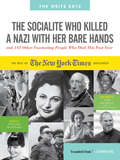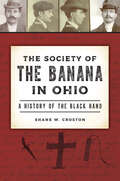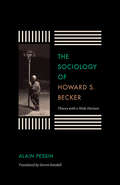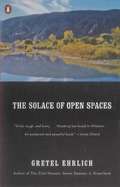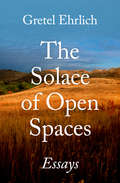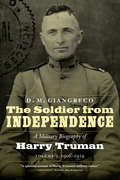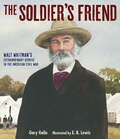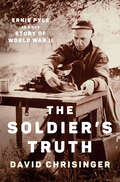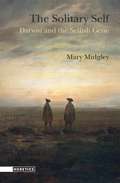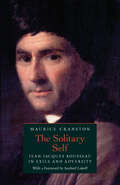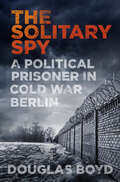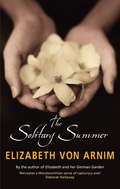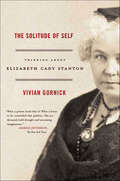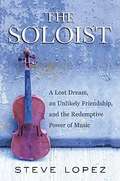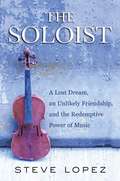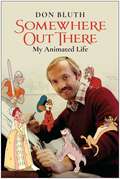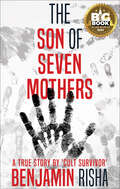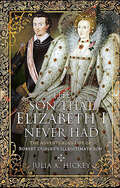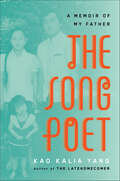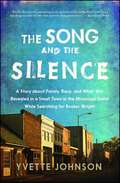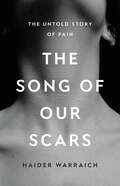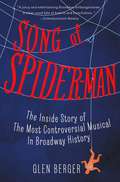- Table View
- List View
The Socialite Who Killed a Nazi with Her Bare Hands and 143 Other Fascinating People Who Died This Past Year: The Best of the New York Times Obituaries, 2013
by William McDonaldReturning for its second year but reimagined in a new impulse format, with a new title, new cover, new mission, and new sensibility, here is The Socialite Who Killed a Nazi with Her Bare Hands, a pithier, quirkier collection of the 164 best page-turning obituaries from The New York Times. <P><P>Written by top journalists, each story is a gem of a bio, a full life in miniature. There’s the famous: Steve Jobs, including the story of how he was reunited with a sister he never knew, the novelist Mona Simpson. And the almost famous: Ruth Stone, a poet who worked in relative obscurity until she won the National Book Award at the age of 87. The behind-the-scenes, like Arch West, inventor of the Dorito, who pulled America’s snacks out of the 1950s doldrums and created a $5-billion-a-year product, and the out-there, like self-styled anarchist and maverick artist (and real estate mogul and museum director) Bob Cassilly, who died at the controls of his bulldozer while building “Cementland” in St. Louis. And because of the chronological organization of the book, the stories, one next to the other, make for an addictive-as-salted-peanuts book: Mark O. Hatfield, the celebrated antiwar Republican senator from Oregon, next to Nancy Wake of the title, the impoverished New Zealander who grew up to become a high-society hostess and heroine of the French Resistance—the socialite who did, indeed, kill a Nazi with her bare hands.
The Society of the Banana in Ohio: A History of the Black Hand (True Crime)
by Shane W. CrostonA notorious case of terror and extortion in the Buckeye StateIn the early 1900s, a criminal society known as the Black Hand became feared across the United States as it extorted hard-working immigrants. In 1908, Agostino Iannarino received a series of threatening letters and when he refused to pay, a bomb exploded at the entrance of his Columbus home. His family fled to Sicily only to continue receiving threats. The following year, U.S. Post Office Inspectors learned that a Black Hand gang called the Society of the Banana was headquartered in Marion, Ohio, and authorities attempted to put an end to the violent outrages occurring across the Midwest.Revealing twenty-four extortion letters written by members of the Society of the Banana, author Shane W. Croston details factual and fatal accounts of the Black Hand.
The Sociology of Howard S. Becker: Theory with a Wide Horizon
by Steven Rendall Alain PessinHoward S. Becker is a name to conjure with on two continents —in the United States and in France. He has enjoyed renown in France for his work in sociology, which in the United States goes back more than fifty years to pathbreaking studies of deviance, professions, sociology of the arts, and a steady stream of books and articles on method. Becker, who lives part of the year in Paris, is by now part of the French intellectual scene, a street-smart jazz pianist and sociologist who offers an answer to the stifling structuralism of Pierre Bourdieu. French fame has brought French analysis, including The Sociology of Howard S. Becker, written by Alain Pessin and translated into English by Steven Rendall. The book is an exploration of Becker’s major works as expressions of the freedom of possibility within a world of collaborators. Pessin reads Becker’s work as descriptions and ideas that show how society can embody the possibilities of change, of doing things differently, of taking advantage of opportunities for free action. The book is itself a kind of collaboration—Pessin and Becker in dialogue. The Sociology of Howard S. Becker is a meeting of two cultures via two great sociological minds in conversation.
The Sociology of Philosophies
by Randall CollinsRandall Collins traces the movement of philosophical thought in ancient Greece, China, Japan, India, the medieval Islamic and Jewish world, medieval Christendom, and modern Europe. What emerges from this history is a social theory of intellectual change, one that avoids both the reduction of ideas to the influences of society at large and the purely contingent local construction of meanings. Instead, Collins focuses on the social locations where sophisticated ideas are formed: the patterns of intellectual networks and their inner divisions and conflicts.
The Solace of Open Spaces
by Gretel EhrlichA stunning collection of personal observations that uses images of the American West to probe larger concerns in lyrical, evocative prose that is a true celebration of the region.
The Solace of Open Spaces: Essays
by Gretel EhrlichThese transcendent, lyrical essays on the West announced Gretel Ehrlich as a major American writer—&“Wyoming has found its Whitman&” (Annie Dillard). Poet and filmmaker Gretel Ehrlich went to Wyoming in 1975 to make the first in a series of documentaries when her partner died. Ehrlich stayed on and found she couldn&’t leave. The Solace of Open Spaces is a chronicle of her first years on &“the planet of Wyoming,&” a personal journey into a place, a feeling, and a way of life. Ehrlich captures both the otherworldly beauty and cruelty of the natural forces—the harsh wind, bitter cold, and swiftly changing seasons—in the remote reaches of the American West. She brings depth, tenderness, and humor to her portraits of the peculiar souls who also call it home: hermits and ranchers, rodeo cowboys and schoolteachers, dreamers and realists. Together, these essays form an evocative and vibrant tribute to the life Ehrlich chose and the geography she loves. Originally written as journal entries addressed to a friend, The Solace of Open Spaces is raw, meditative, electrifying, and uncommonly wise. In prose &“as expansive as a Wyoming vista, as charged as a bolt of prairie lightning,&” Ehrlich explores the magical interplay between our interior lives and the world around us (Newsday).
The Solace of Stones: Finding a Way through Wilderness (American Lives)
by Julie RiddleEverything changes when Julie Riddle’s parents stumble across the wilderness survival guide How to Live in the Woods on Pennies a Day. In 1977, when Riddle is seven years old, she and her family—fed up with the challenges of city life—move to the foot of the Cabinet Mountains Wilderness in northwestern Montana. For three years they live in the primitive basement of the log house they are building by hand in the harsh, remote Montana woods. Meanwhile, haunted by the repressed memory of childhood sexual abuse, Riddle struggles to come to terms with the dark shadows that plague her amid entrenched cultural and gender mores enforced by enduring myths of the West. As Riddle grapples with her own painful secrets, she discovers the world around her and its impact on people—the demands of living in a rural, mountain community dependent on boom-and-bust mining and logging industries, the health and environmental crises of the W. R. Grace asbestos contamination and EPA cleanup, and the healing beauty of the Montana wild. More than simply a memoir about family and place, The Solace of Stones explores Riddle’s coming of age and the complexities of memory, loss, and identity borne by a family homesteading in the modern West.
The Soldier from Independence: A Military Biography of Harry Truman, Volume 1, 1906-1919
by D. M. Giangreco Alonzo L. HambyRevealing the little-known facts of Harry Truman’s remarkable military performance, as a soldier and as a politician, The Soldier from Independence adds a whole new dimension to the already fascinating character of the thirty-third president of the United States. D. M. Giangreco shows how, as a field artillery battery commander in World War I, Truman was already making the hard decisions that he knew to be right, regardless of personal consequences. Truman oversaw the conclusion of the Second World War, stood up to Stalin, and met the test of North Korea’s invasion of the South. He also had the fortitude to defy Gen. Douglas MacArthur, one of America’s most revered wartime leaders, and ultimately fired the Far East commander, often characterized as the American Caesar. Filling in the details behind these world-changing events, this military biography supplies a heretofore missing—and critical—chapter in the story of one of the nation’s most important presidents. The Soldier from Independence recounts the World War I military adventure that would mark a turning point in the life of a humble man who would go on to become commander in chief.
The Soldier's Friend: Walt Whitman's Extraordinary Service in the American Civil War
by Gary GolioWalt Whitman is celebrated as an iconic American poet, but few know of the crucial and heroic role he played tending to the wounded and dying in Civil War hospitals. This nonfiction picture book highlights Whitman&’s compassion and teaches an important lesson about empathy, making this a perfect social-emotional learning title for young readers.In December of 1862, Walt Whitman left Brooklyn, New York, for the war-torn South after seeing his brother's name on a list of wounded Union soldiers. What he found on the battlefields completely changed his life, as he came face to face with not only the wounded, but the dying. Whitman spent the next three years working part-time in Washington, DC, visiting and ministering to soldiers in the city&’s many military hospitals. Caring for the sick and dying was not easy, but Whitman was committed to his chosen service. He became known as "the soldiers&’ friend," and was bound—in his own way—to save and heal the America he wrote about and loved so deeply.New York Times-bestselling author Gary Golio and Caldecott Honor artist E. B. Lewis bring Whitman&’s story and his passion for America to life, complete with quotes from Whitman&’s works, and extensive backmatter, which includes a bibliography and photographs.
The Soldier's Truth: Ernie Pyle and the Story of World War II
by David ChrisingerA beautiful reckoning with the life and work of the legendary journalist Ernie Pyle, who gave World War II a human face for millions of Americans even as he wrestled with his own demonsAt the height of his fame and influence during World War II, Ernie Pyle&’s nationally syndicated dispatches from combat zones shaped America&’s understanding of what the war felt like to ordinary soldiers, as no writer&’s work had before or has since. From North Africa to Sicily, from the beaches of Anzio to the beaches of Normandy, and on to the war in the Pacific, where he would meet his end, Ernie Pyle had a genius for connecting with his beloved dogfaced grunts. A humble man, himself plagued by melancholy and tortured by marriage to a partner whose mental health struggles were much more acute than his own, Pyle was in touch with suffering in a way that left an indelible mark on his readers. While never defeatist, his stories left no doubt as to the heavy weight of the burden soldiers carried. He wrote about post-traumatic stress long before that was a diagnosis.In The Soldier's Truth, acclaimed writer David Chrisinger brings Pyle&’s journey to vivid life in all its heroism and pathos. Drawing on access to all of Pyle&’s personal correspondence, his book captures every dramatic turn of Pyle&’s war with sensory immediacy and a powerful feel for both the outer and the inner landscape. With a background in helping veterans and other survivors of trauma come to terms with their experiences through storytelling, Chrisinger brings enormous reservoirs of empathy and insight to bear on Pyle&’s trials. Woven in and out of his chronicle is the golden thread of his own travels across these same landscapes, many of them still battle-scarred, searching for the landmarks Pyle wrote about.A moving tribute to an ordinary American hero whose impact on the war is still too little understood, and a powerful account of that war&’s impact and how it is remembered, The Soldier's Truth takes its place among the essential contributions to our perception of war and how we make sense of it.
The Solitary Self: Darwin and the Selfish Gene
by Mary MidgleyRenowned philosopher Mary Midgley explores the nature of our moral constitution to challenge the view that reduces human motivation to self-interest. Midgley argues cogently and convincingly that simple, one-sided accounts of human motives, such as the 'selfish gene' tendency in recent neo-Darwinian thought, may be illuminating but are always unrealistic. Such neatness, she shows, cannot be imposed on human psychology. She returns to Darwin's original writings to show how the reductive individualism which is now presented as Darwinism does not derive from Darwin but from a wider, Hobbesian tradition in Enlightenment thinking. She reveals the selfish gene hypothesis as a cultural accretion that is just not seen in nature. Heroic independence is not a realistic aim for Homo sapiens. We are, as Darwin saw, earthly organisms, framed to interact constantly with one another and with the complex ecosystems of which we are a tiny part. For us, bonds are not just restraints but also lifelines.
The Solitary Self: Jean-Jacques Rousseau in Exile and Adversity
by Maurice CranstonA monumental achievement, Maurice Cranston's trilogy provides the definitive account of Jean-Jacques Rousseau's turbulent life. Now available in paperback, this final volume completes a masterful biography of one of the most important philosophers of all time. The Solitary Self traces the last tempestuous years of Rousseau's life.
The Solitary Spy: A Political Prisoner in Cold War Berlin
by Douglas BoydOf the 2.3 million National Servicemen conscripted during the Cold War, 4,200 attended the secret Joint Services School for Linguists, tasked with supplying much-needed Russian speakers to the three services. The majority were in RAF uniform, as the Warsaw Pact saw air forces become the greatest danger to the West. After training, they were sent to the front lines in Germany and elsewhere to snoop on Russian aircraft in real time. Posted to RAF Gatow in Berlin, ideally placed for signals interception, Douglas Boyd came to know Hitler’s devastated former capital, divided as it was into Soviet, French, US and British sectors. Pulling no punches, he describes the SIGINT work, his subsequent arrest by armed Soviet soldiers one night on the border, and how he was locked up without trial in solitary confinement in a Stasi prison. The Solitary Spy is a unique account of the terrifying experience of incarceration and interrogation in an East German political prison, from which Boyd eventually escaped one step ahead of the KGB.
The Solitary Summer (Virago Modern Classics #401)
by Elizabeth von ArnimI want to be alone for a whole summer, and get to the very dregs of life. I want to be as idle as I can, so that my soul may have time to grow. Nobody shall be invited to stay with me, and if anyone calls they will be told that I am out, or away, or sick . . . Wouldn't a whole lovely summer, quite alone, be delightful?'This delightful companion to the famous Elizabeth and her German Garden is a witty, lyrical account of a rejuvenating, solitary summer filled with books and Elizabeth's reflections on her beloved garden. Descriptions of magnificent larkspurs and burning nasturtiums give way to those of cooling forest walks. Yet the months aren't as solitary as she'd planned: there's still her husband to pacify and the April, May and June babies to amuse.
The Solitude of Self: Thinking About Elizabeth Cady Stanton
by Vivian GornickElizabeth Cady Stanton—along with her comrade-in-arms, Susan B. Anthony—was one of the most important leaders of the movement to gain American women the vote. But, as Vivian Gornick argues in this passionate, vivid biographical essay, Stanton is also the greatest feminist thinker of the nineteenth century. Endowed with a philosophical cast of mind large enough to grasp the immensity that women's rights addressed, Stanton developed a devotion to equality uniquely American in character. Her writing and life make clear why feminism as a liberation movement has flourished here as nowhere else in the world.Born in 1815 into a conservative family of privilege, Stanton was radicalized by her experience in the abolitionist movement. Attending the first international conference on slavery in London in 1840, she found herself amazed when the conference officials refused to seat her because of her sex. At that moment she realized that "In the eyes of the world I was not as I was in my own eyes, I was only a woman." At the same moment she saw what it meant for the American republic to have failed to deliver on its fundamental promise of equality for all. In her last public address, "The Solitude of Self," (delivered in 1892), she argued for women's political equality on the grounds that loneliness is the human condition, and that each citizen therefore needs the tools to fight alone for his or her interests.Vivian Gornick first encountered "The Solitude of Self" thirty years ago. Of that moment Gornick writes, "I hardly knew who Stanton was, much less what this speech meant in her life, or in our history, but it I can still remember thinking with excitement and gratitude, as I read these words for the first time, eighty years after they were written, ‘We are beginning where she left off.' "The Solitude of Self is a profound, distilled meditation on what makes American feminism American from one of the finest critics of our time.
The Soloist (Movie Tie-In): A Lost Dream, an Unlikely Friendship, and the Redemptive Power of Music
by Steve LopezNow a major motion picture-"An intimate portrait of mental illness, of atrocious social neglect, and the struggle to resurrect a fallen prodigy." (Mark Bowden, author of Black Hawk Down) This is the true story of journalist Steve Lopez's discovery of Nathaniel Ayers, a former classical bass student at Julliard, playing his heart out on a two-string violin on Los Angeles' Skid Row. Deeply affected by the beauty of Ayers's music, Lopez took it upon himself to change the prodigy's life-only to find that their relationship has had a profound change on his own life.
The Soloist: A Lost Dream, an Unlikely Friendship, and the Redemptive Power of Music
by Steve LopezWhen reporter Steve Lopez sees Nathaniel Ayers playing his heart out on a 2-string violin in LA's Skid Row, he finds it impossible to walk away. At first, he sees it as fodder for his column, but what Lopez begins to unearth about the mysterious street musician leaves an indelible impression. More than 30 years earlier, Ayers had been a promising classical bass student at Juilliard - ambitious, charming, and one of the few African-Americans at the school - until he gradually lost his ability to function, overcome by a mental breakdown. When Lopez finds him, Ayers is alone, suspicious of everyone, and deeply troubled, but glimmers of brilliance are still there.
The Somewhere Out There: My Animated Life
by Don BluthAfter more than five decades in Hollywood, Don Bluth, the man behind some of the most iconic animated films ever made, tells his story. Don Bluth never felt like a Donald. So people have always called him Don. A matinee of Snow White and the Seven Dwarfs awakened something within him. Despite growing up in rural Texas and Utah, he practiced and worked hard to become an Hollywood animator. And after working alongside his idol Walt Disney, and on films including Sleeping Beauty, The Sword in the Stone, Robin Hood, Winne the Pooh, The Rescuers, and Pete&’s Dragon, he realized that the company had changed into something he didn&’t necessarily believe in. So made the industry-shocking decision to start his own animation studio. It was from that studio—Don&’s studio—that came such award-winning, generation-defining films as The Secret of NIMH, An American Tail, The Land Before Time, All Dogs Go to Heaven, Anastasia, and the video game Dragon&’s Lair. Now, after more than half a century in the movie business, Don is ready to tell the story of his life. How his passions for artistry, integrity, and his Mormon faith shaped him into the beloved icon whose creativity, entrepreneurship, and deeply-held beliefs entertained, enthralled, and inspired millions across the globe. Exclusive original art makes this book perfect for fans, cineasts, and anyone looking &“somewhere out there&” for inspiration and motivation.
The Son of Seven Mothers: A True Story by a 'Cult Survivor'
by Benjamin RishaA man shares his story of growing up in a late 20th-century American cult—and how he escaped—in this gripping autobiography. As the adopted son of two cult leaders, Benjamin Risha was raised to someday assume a place of leadership in the Alamo Christian Foundation, with the Bible, and his parents&’ interpretations of it, as his guide. He believed the prophecies of his adoptive mother and father, Tony and Susan Alamo, including them being the two prophets foretold in the Book of Revelations who precede the second coming of Jesus Christ, them rising from the dead after they died, and such dire warnings as the ground opening up to swallow non-believers into hell. And he was sure that Susan Alamo could raise the dead as promised. However, when none of it happened, and the foundation slid from bucolic communal lifestyle to insufferable criminality that included absolute obedience to the Alamos, and polygamous marriages with girls as young as eight years old, Benjamin knew he had to escape. If he were caught trying to escape, he would be severely beaten, forced to go without food and water for his sins, and shamed in the community. So, he embarked on a journey to locate his birth parents, discover the truth about a world he knew nothing about . . . and find himself. In The Son of Seven Mothers, Benjamin Risha takes readers on a harrowing journey that few in the United States can imagine. And eventually he must choose between the life he knows and was &“chosen&” to lead, and his freedom.
The Son that Elizabeth I Never Had: The Adventurous Life of Robert Dudley’s Illegitimate Son
by Julia A. HickeySir Robert Dudley, the handsome ‘base born’ son of Elizabeth I’s favourite, was born amidst scandal and intrigue. The story of his birth is one of love, royalty and broken bonds of trust. He was at Tilbury with the Earl of Leicester in 1587; four years later he was wealthy, independent and making a mark in Elizabeth’s court; he explored Trinidad, searched for the fabled gold of El Dorado and backed a voyage taking a letter from the queen to the Emperor of China. He took part in the Earl of Essex’s raid on Cadiz and was implicated in the earl’s rebellion in 1601 but what he wanted most was to prove his legitimacy. Refusing to accept the lot Fate dealt him after the death of the Queen, he abandoned his family, his home and his country never to return. He carved his own destiny in Tuscany as an engineer, courtier, shipbuilder and seafarer with the woman he loved at his side. His sea atlas, the first of its kind, was published in 1646. The Dell’Arcano del Mare took more than twelve years to write and was the culmination of a lifetime’s work. Robert Dudley, the son Elizabeth never had, is the story of a scholar, an adventurer and Elizabethan seadog that deserves to be better known.
The Song Poet: A Memoir of My Father
by Kao Kalia YangThis “memorable and moving immigrant story” chronicles the life of the author’s father, a Hmong refugee and keeper of cultural memory (Booklist).Winner of the 2017 Minnesota Book Award in Creative NonfictionA National Book Critics Circle Award FinalistIn the Hmong tradition, the song poet recounts the story of his people, their history and tragedies, joys and losses. He keeps the past alive, invokes the spirits and the homeland, and records courtships, births, weddings, and wishes. Following her award-winning memoir The Latehomecomer, Kao Kalia Yang now retells the life of her father, Bee Yang, the song poet—a Hmong refugee in Minnesota, driven from the mountains of Laos by America’s Secret War.Bee sings the life of his people through the war-torn jungle and a Thai refugee camp. The songs fall away in the cold, bitter world of a St. Paul housing project and on the factory floor, until, with the death of Bee’s mother, they leave him for good. But before they do, Bee, with his poetry, has burnished a life of poverty for his children, polishing their grim reality so that they might shine.
The Song and the Silence: A Story about Family, Race, and What Was Revealed in a Small Town in the Mississippi Delta While Searching for Booker Wright
by Yvette JohnsonIn this moving memoir, Yvette Johnson travels to the Mississippi Delta to uncover true the story of her late grandfather Booker Wright whose extraordinary act of courage would change both their lives forever.“Have to keep that smile,” Booker Wright said in the 1966 NBC documentary Mississippi: A Self-Portrait. At the time, Wright spent his evenings waiting tables for Whites at a local restaurant and his mornings running his own business. The ripple effect from his remarks would cement Booker as a civil rights icon because he did the unthinkable: before a national audience, Wright described what life truly was like for the Black people of Greenwood, Mississippi. Four decades later, Yvette Johnson, Wright’s granddaughter, found footage of the controversial documentary. No one in her family knew of his television appearance. Even more curious for Johnson was that for most of her life she’d barely heard mention of her grandfather’s name. Born a year after Wright’s death and raised in a wealthy San Diego neighborhood, Johnson admits she never had to confront race the way Southern Blacks did in the 1960s. Compelled to learn more about her roots, she travels to Greenwood, Mississippi, a beautiful Delta town steeped in secrets and a scarred past, to interview family members and townsfolk about the real Booker Wright. As she uncovers her grandfather’s compelling story and gets closer to the truth behind his murder, she also confronts her own conflicted feelings surrounding race, family, and forgiveness. Told with powerful insights and harrowing details of civil rights–era Mississippi, The Song and the Silence is an astonishing chronicle of one woman’s passionate pursuit of her own family’s past. In the stories of those who came before, she finds not only a new understanding of herself, but a hopeful vision of the future for all of us.
The Song of Bernadette
by Franz Werfel Ludwig Lewisohn"This book is the fulfilment of my vow. In our epoch an epic poem can take no form but that of a novel. The Song of Bernadette is a novel but not a work of fiction. In face of the events here delineated, the sceptical reader will ask with better right than in the case of most historical epic narratives: 'What is true? What is fiction?' My answer is: All the memorable happenings which constitute the substance of this book took place in the world of reality. Since their beginning dates back no longer than eighty years, there beats upon them the bright light of modern history and their truth has been confirmed by friend and foe and by unbiased observers. My story makes no changes in this body of truth. I exercised my right of creative freedom only where the work, as a work of art, demanded certain chronological condensations or where there was need of striking the spark of life from the hardened substance. I have dared to sing the song of Bernadette, although I am not. a Catholic but a Jew; and I drew courage for this undertaking from a far older and far more unconscious vow of mine. Even in the days when I wrote my first verses I vowed that I would evermore and everywhere in all I wrote magnify the divine mystery and the holiness of man - careless of a period which has turned away with scorn and rage and indifference from these ultimate values of our mortal lot."
The Song of Our Scars: The Untold Story of Pain
by Haider WarraichA doctor&’s personal and unsparing account of how modern medicine&’s failure to understand pain has made care less effectiveIn The Song of Our Scars, physician Haider Warraich offers a bold reexamination of the nature of pain, not as a simple physical sensation, but as a cultural experience.Warraich, himself a sufferer of chronic pain, considers the ways our notions of pain have been shaped not just by science but by politics and power, by whose suffering mattered and whose didn&’t. He weaves a provocative history from the Renaissance, when pain transformed into a medical issue, through the racial legacy of pain tolerance, to the opiate epidemics of both the nineteenth and twenty-first centuries, to the cutting edge of present-day pain science. The conclusion is clear: only by reckoning with both pain&’s complicated history and its biology can today&’s doctors adequately treat their patients&’ suffering.Trenchant and deeply felt, The Song of Our Scars is an indictment of a broken system and a plea for a more holistic understanding of the human body.
The Song of Spider-Man
by Glen BergerFrom the show's cowriter who saw it all firsthand, this is the epic story of the most expensive, ambitious, dangerous, and controversial Broadway musical of all-time: Spider-Man.Never in the history of Broadway has there been anything like Spider-Man: Turn Off the Dark. Lampooned by reviewers, loved and loathed by audiences, and boldly envisioned by its producers, Spider-Man has forever made its mark in pop culture history. Author Glen Berger was present at the creation, when visionary director Julie Taymor selected him to collaborate with her on the book of the musical. For seven years, Berger was an eyewitness to great artistic hopes and battles as Taymor sought to bring her vision to the stage, along with celebrated rock stars Bono and the Edge. But despite terrible reviews and public ridicule, Spider-Man went on to become one of the top ten grossing musicals in the history of Broadway--a feat inseparable from its creators' unassailable passion, immense efforts, and artistic ambition. With a sharp eye for detail and candid sense of humor, Berger reveals every aspect--the highs and lows--of the production and in doing so, takes us inside the theatrical process in a way few authors can. The Song of Spider-Man is the ultimate fly-on-the-wall account of how Broadway works, how big musicals are made, and how great artists continue to dream, even in the midst of a nightmare.
